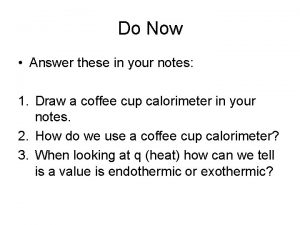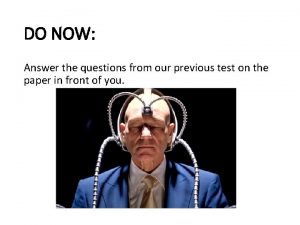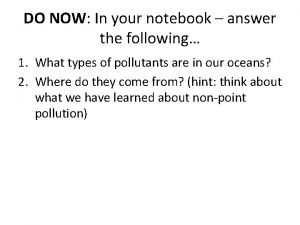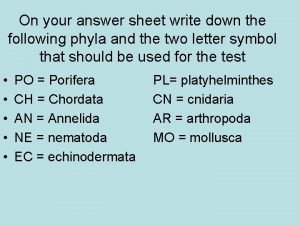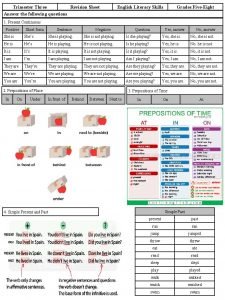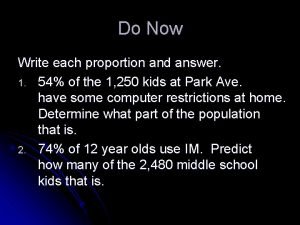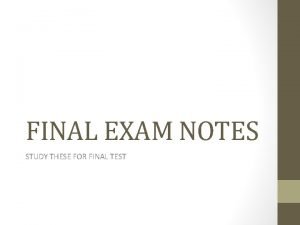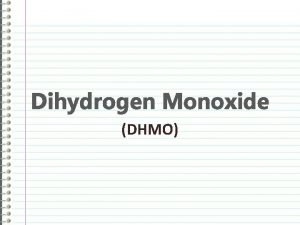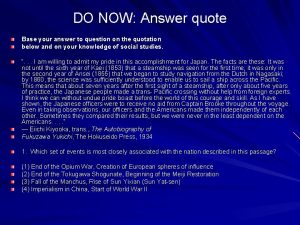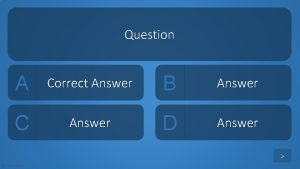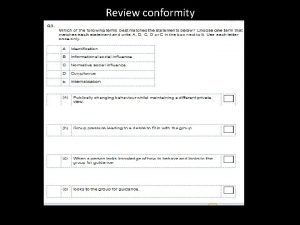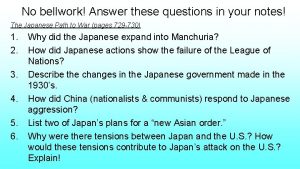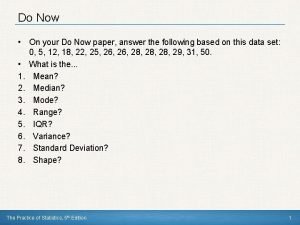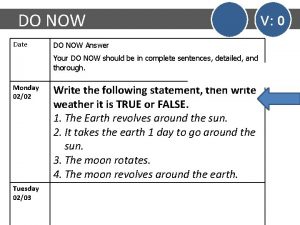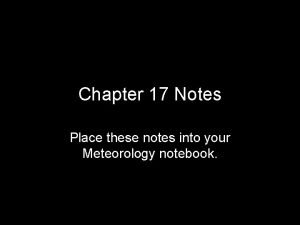Do Now Answer these in your notes 1














- Slides: 14

Do Now • Answer these in your notes: 1. Draw a coffee cup calorimeter in your notes. 2. How do we use a coffee cup calorimeter? 3. When looking at q (heat) how can we tell is a value is endothermic or exothermic?

Exothermic A reaction that is exothermic gives off heat and the change in enthalpy is negative (ΔH° < 0). The temperature of the surroundings increases during an exothermic process. Copyright © Cengage Learning. All rights 2

Endothermic A reaction that is endothermic absorbs heat and the change in enthalpy is positive (ΔH° > 0). The temperature of the surroundings decreases in an endothermic process. Copyright © Cengage Learning. All rights 3

A Coffee–Cup Calorimeter Made of Two Styrofoam Cups Copyright © Cengage Learning. All rights 4

Calorimetry • Calorimetry is the measurement of heat flow. • It allows us to calculate the amount of energy required to heat up a substance or to make a substance change states.

Direction of Heat Flow Surroundings ENDOthermic qsys > 0 System H 2 O(s) + heat H 2 O(l) melting Kotz, Purcell, Chemistry & Chemical Reactivity 1991, page 207 EXOthermic qsys < 0 H 2 O(l) H 2 O(s) + heat System freezing

Experimental Determination of Specific Heat of a Metal Typical apparatus used in this activity include a boiler (such as large glass beaker), a heat source (Bunsen burner or hot plate), a stand or tripod for the boiler, a calorimeter, thermometers, samples (typically samples of copper, aluminum, zinc, tin, or lead), tongs (or forceps or string) to handle samples, and a balance.

A Coffee Cup Calorimeter Thermometer Styrofoam cover Styrofoam cups Stirrer Zumdahl, De. Coste, World of Chemistry 2002, page 302

Calorimetry • Energy released (heat) = m × c × ΔT s (sometimes c) = specific heat capacity (J/°C·g) m = mass (g) ΔT = change in temperature (°C) Copyright © Cengage Learning. All rights reserved 9

Calorimetry • Experimental way of measuring heat generation/consumption by essentially catching all the heat energy in a water bath or water bath + metal apparatus. • Coffee Cup Calorimetry • Styrofoam cup insulates the contents so any heat generated or consumed in the water can be measured by the temperature change • -qmetal = m. CH 2 O∆T

Calorimetry Surroundings SYSTEM Tfinal = 26. 7 o. C “loses” heat H 2 O Ag m = 75 g T = 25 o. C m = 30 g T = 100 o. C

240 g of water (initially at 20 o. C) are mixed with an unknown mass of iron (initially at 500 o. C). When thermal equilibrium is reached, the system has a temperature of 42 o. C. Find the mass of the iron. Fe T = 500 o. C mass = ? grams s = 0. 45 J/go. C T = 20 o. C mass = 240 g -q. Fe= qwater - [(s. Fe) (m. Fe) (DTFe)] = (Swater) (mwater) (DTwater) m. Fe = 107. 3 g Fe Calorimetry Problems 2 question #5

A 97 g sample of gold at 785 o. C is dropped into 323 g of water, which has an initial temperature of 15 o. C. If gold has a specific heat of 0. 129 J/go. C, what is the final temperature of the mixture? Assume that the gold experiences no change in state of matter. Au T = 785 o. C mass = 97 g T = 15 o. C mass = 323 g -q. Au= qwater - [(s. Au) (m. Au) (DTAu)] = (Swater) (mwater) (DTwater) - [(0. 129 J/go. C) (97 g) (Tf - 785 o. C)] = (4. 184 J/go. C) (323 g) (Tf - 15 o. C)] Tf = 22. 1 o. C Calorimetry Problems 2 question #8

A 322 g sample of lead (specific heat = 0. 138 J/go. C) is placed into 264 g of water at 25 o. C. If the system's final temperature is 46 o. C, what was the initial temperature of the lead? Pb T = ? o. C mass = 322 g Ti = 25 o. C mass = 264 g Tf = 46 o. C Pb -q. Pb= qwater - [(s. Pb) (m. Pb) (DTPb)] = (Swater) (mwater) (DTwater) - [(0. 138 J/go. C) (322 g) (46 o. C - Ti)] = (4. 184 J/go. C) (264 g) (46 o. C- 25 o. C)] Ti = 568 o. C Calorimetry Problems 2 question #12
 Answer the following questions in your notebook en español
Answer the following questions in your notebook en español Slide to answer
Slide to answer Now answer these questions
Now answer these questions Now answer these questions
Now answer these questions 2 read and answer write in your notebook
2 read and answer write in your notebook Now answer the following questions in your notebook
Now answer the following questions in your notebook In your notebook, answer the following questions.
In your notebook, answer the following questions. Now i see it now you don't
Now i see it now you don't Indoor outdoor sports
Indoor outdoor sports On your answer sheet answer the following questions
On your answer sheet answer the following questions Trimester fill in worksheet answers
Trimester fill in worksheet answers Solve each proportion write your answer in your notebook
Solve each proportion write your answer in your notebook Give us your hungry your tired your poor
Give us your hungry your tired your poor What are these notes
What are these notes Cube wisc
Cube wisc


